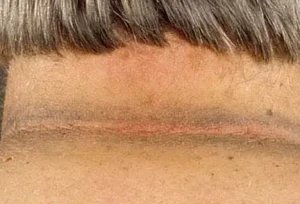Overview
Diagnosis
The diagnosis of acanthosis nigricans is primarily clinical, based on characteristic changes in the skin.
-
Physical Examination:
A healthcare professional can typically identify acanthosis nigricans by observing areas of hyperpigmentation and thickened, velvety skin—commonly seen on the neck, axillae, groin, or other flexural regions. -
Skin Biopsy:
If the clinical presentation is uncertain or if additional evaluation is required, a small sample of affected skin may be taken for histopathological examination. Microscopic findings often reveal hyperkeratosis, papillomatosis, and minimal inflammation, which support the diagnosis. -
Laboratory Evaluation:
Additional tests may be ordered to identify or rule out underlying conditions. This can include blood tests to evaluate blood glucose levels, insulin resistance, or hormonal abnormalities, especially in patients with sudden onset or widespread lesions.
Treatment of Acanthosis Nigricans
There is no specific cure for acanthosis nigricans. Management focuses on treating the underlying cause and improving the appearance and comfort of the affected skin.
-
Addressing the Underlying Cause:
-
Weight Reduction: For patients with obesity-associated acanthosis nigricans, lifestyle modification and weight loss can lead to significant improvement in skin changes.
-
Medication Review: If the condition is linked to a particular medication or supplement, discontinuation or substitution may be recommended under medical supervision.
-
Oncologic Evaluation: In rare cases where a malignant tumor (often gastrointestinal or genitourinary) triggers the condition, surgical removal of the tumor can lead to resolution of skin lesions.
-
-
Symptomatic and Cosmetic Management:
-
Topical Therapies: Keratolytic creams, retinoids, or other prescribed skin treatments may help soften thickened areas and reduce pigmentation.
-
Hygiene Measures: Use of antibacterial or specialized cleansing agents can help minimize odor or irritation.
-
Procedural Options: Dermatologic procedures such as laser therapy or chemical peels may be considered for cosmetic improvement when appropriate.
-
Advertisement

